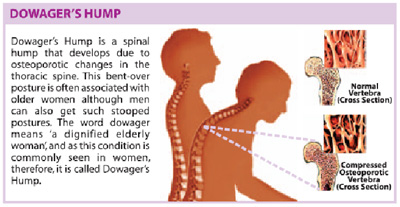Osteoporosis, a common yet neglected condition, affects one in three women and one in five men over the age of fifty. However, this bone disorder can strike a person at any age. A quick glance on this global problem and its consequences…
Osteoporosis, which literally means ‘porous bone’, is a disease in which the bone mass and bone strength are reduced. As we get older, we are no longer able to replace bone tissue as quickly as we lose it. Osteoporosis occurs when new bone formation does not match the bone loss. If not prevented or left untreated, the loss of bone occurs ‘silently’ and progressively. This reduces the density of bone, making them weak and easy to break, resulting in fractures.
As the loss is gradual and painless, often there are no symptoms until the first fracture occurs. The most common fractures associated with osteoporosis occur at the hip, spine and wrist. Spinal fractures can result in serious consequences, including loss of height, intense back pain and deformity. A hip fracture often requires surgery and may result in loss of independent living. But in some cases, a stooped back and loss in height may be the only visible signs that a person has osteoporosis.
However, osteoporosis is a preventable and treatable condition. A combination of lifestyle changes and appropriate medical treatment can prevent fractures. Recent advances in treatment of osteoporosis not only prevent further bone loss but can also lead to the formation of new bone.
Therefore, if you are more than 50 years or have any of the risk factors, or have had a fracture at wrist, spine or hip, then it is highly recommended that you seek advice from an expert to assess your bone health status and take the necessary treatment to prevent further complications.
Risk Factors
- Aging
- Gender – Women are four times more likely to develop osteoporosis than men
- A family history of osteoporosis or broken bones
- Having a thin, small-framed body
- Lack of exercise, especially weight bearing ones, such as walking
- Long-term bed rest
- Low calcium and vitamin D intake or absorption
- Smoking
- Drinking too much alcohol
- Long term use of some medicines like steroids
- Certain other diseases like asthma, thyroid disorders and arthritis
In women, the rate of bone loss increases significantly after menopause when oestrogen hormone production stops and bones no longer benefit from its protective effect. Men also suffer from loss of bone tissue, but the rate of loss is much slower.
Osteoporosis Facts

- Osteoporosis is common in India, and high prevalence of vitamin D deficiency among Indians is one of the major reasons for this condition
- Osteoporosis is a silent disease. You might not know you have it until you fracture a bone
- Osteoporosis weakens bones and causes fractures that can result in severe disability
- It is important to encourage children to drink milk and play in the sun so as to ensure adequate calcium intake and vitamin D synthesis
- Peak bone density is reached at approximately 25 years of age. Therefore, it is important to build strong bones by this age so that the bones will remain strong later in life
- A bone mineral density test is the best way to check your bone health
IF You…
- Are post menopause and have constant pain in your neck or lower back, then you should consult your doctor for further evaluation
- Feel severe pain in your muscles or bones that limits your ability to function, then check with your doctor immediately
- Have sustained trauma or suspect fractures in the spine, hip or wrist, do an entire health check up after consulting your doctor and take the necessary treatment


